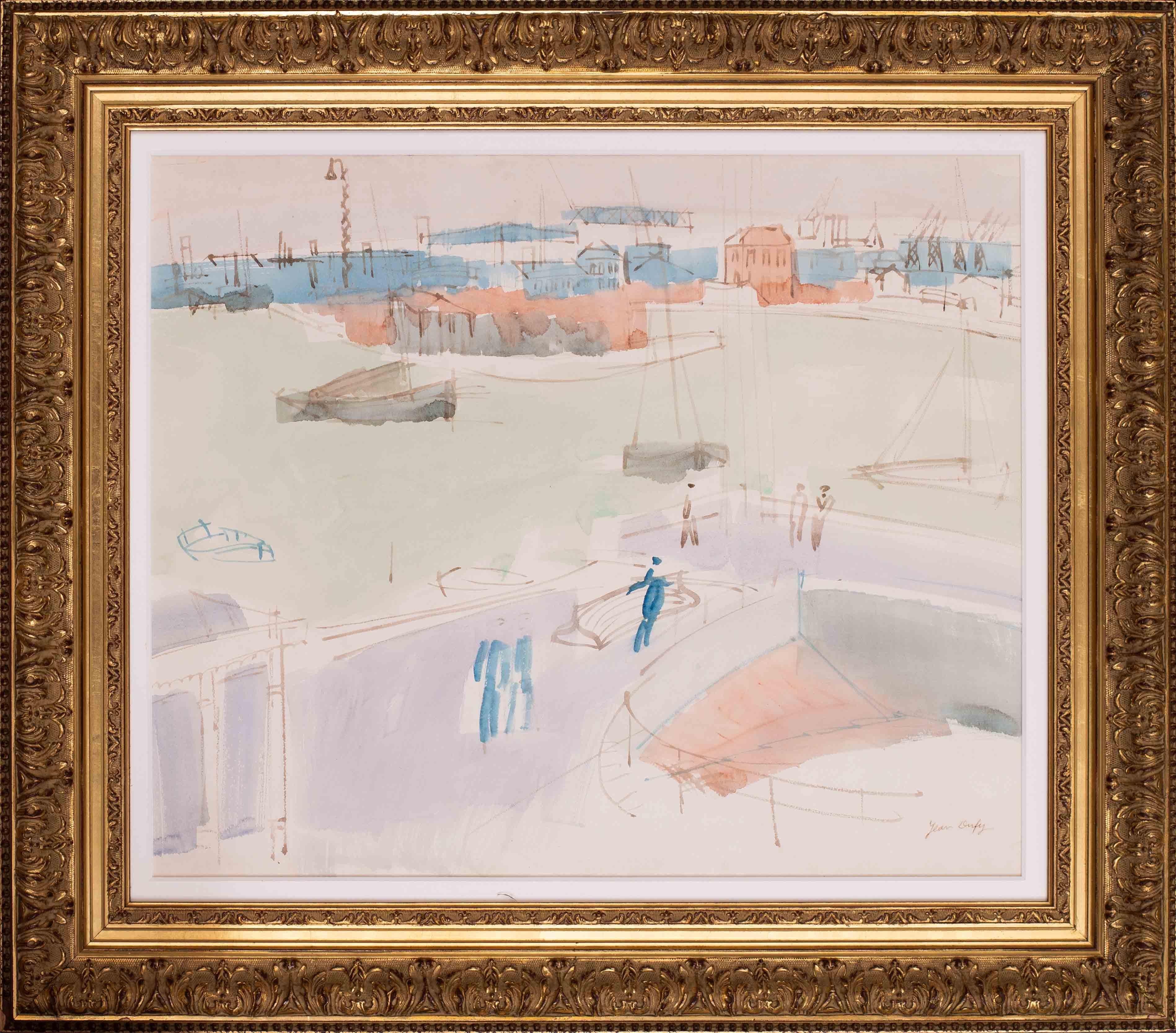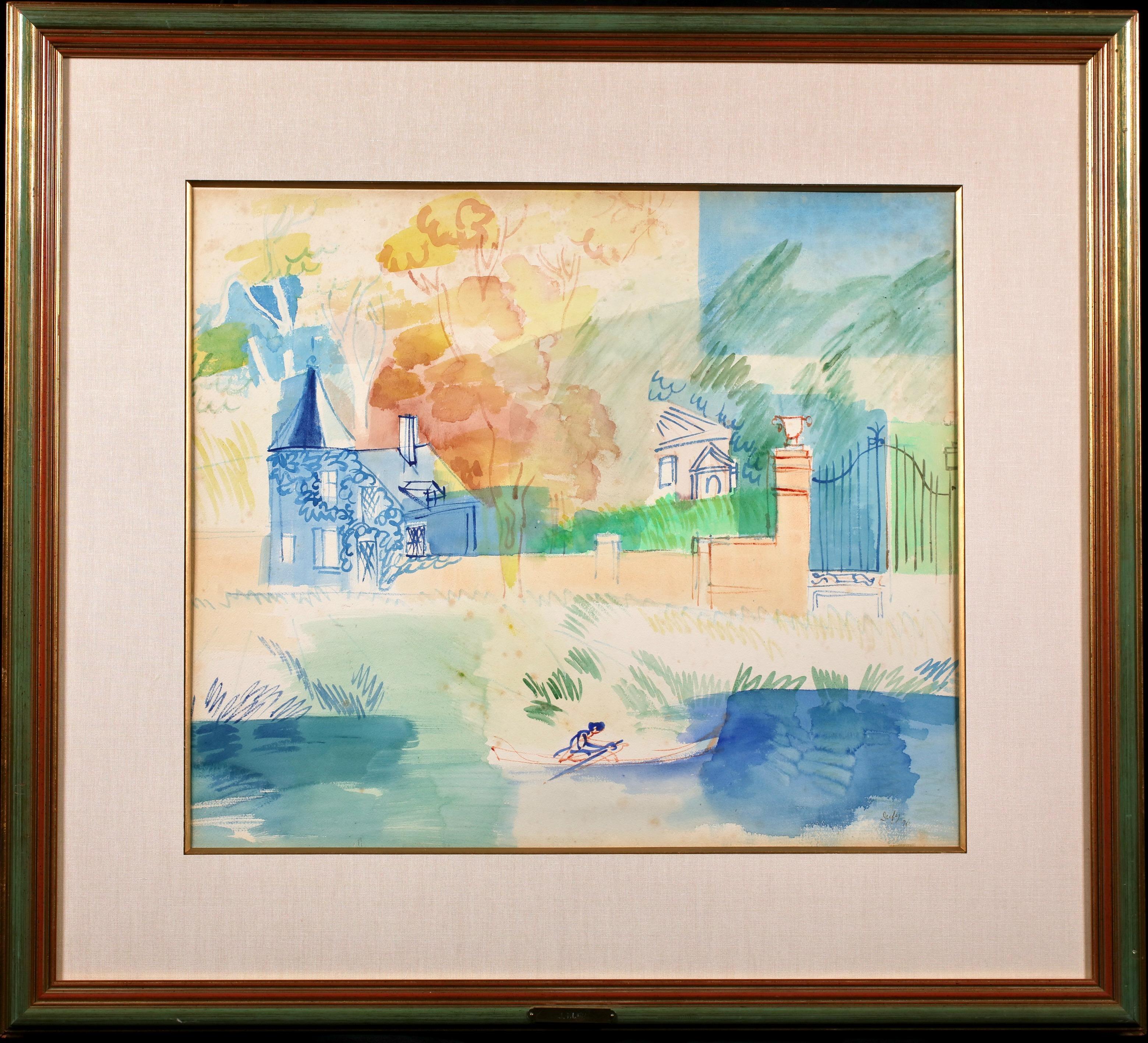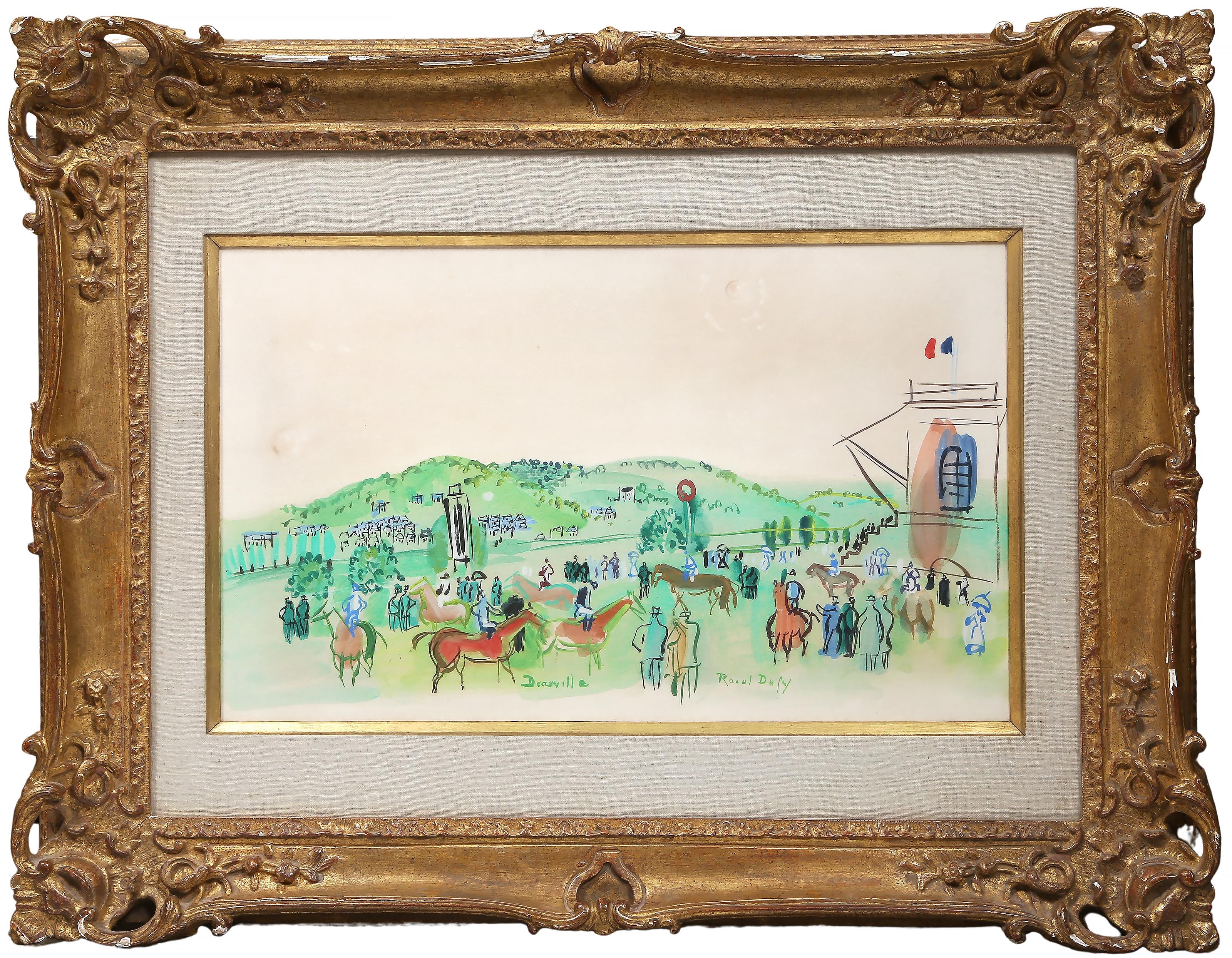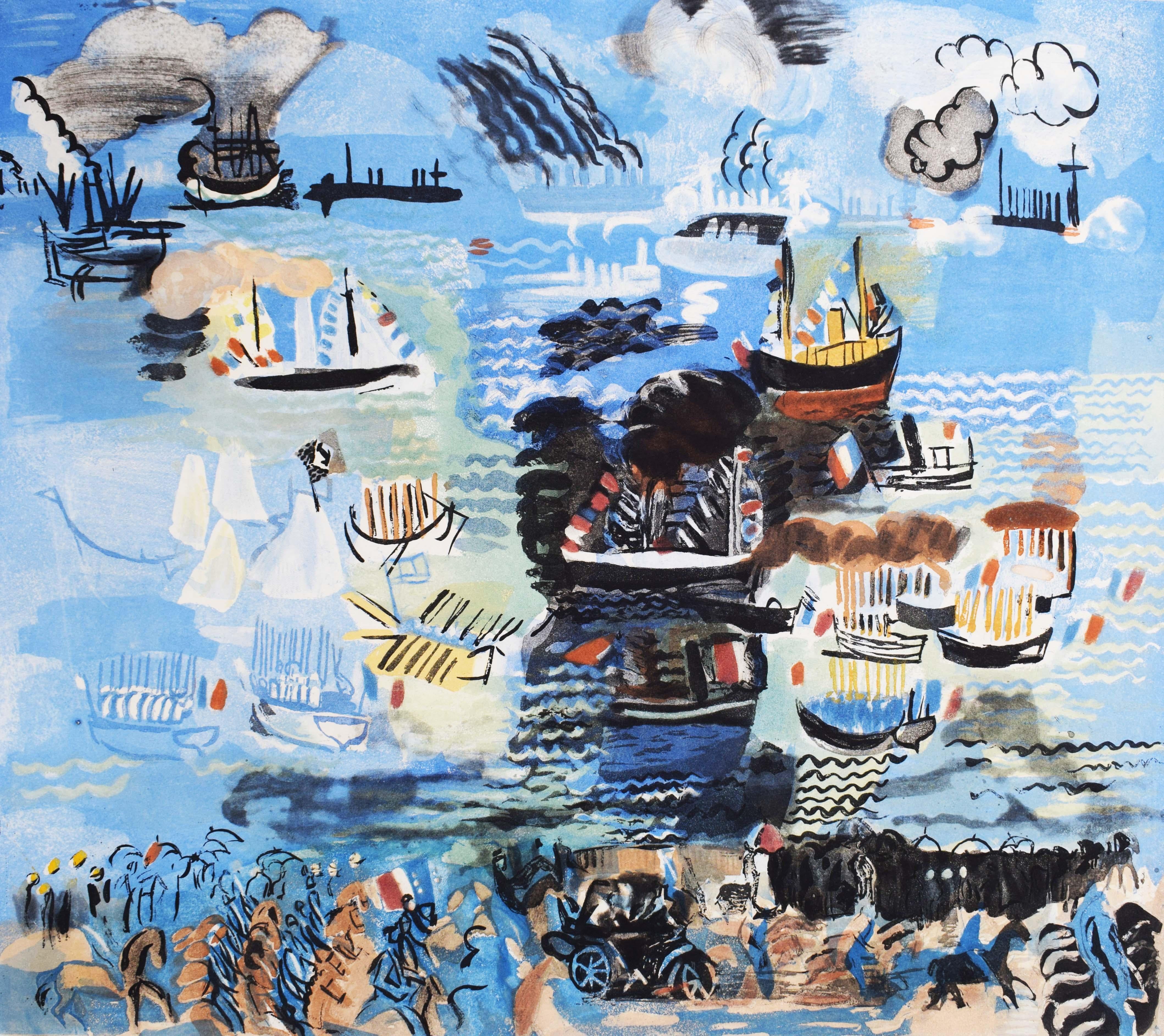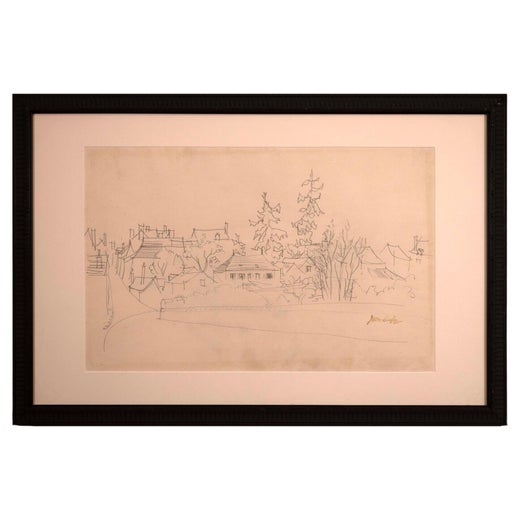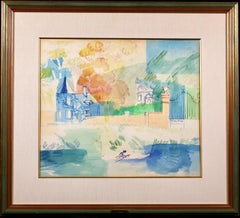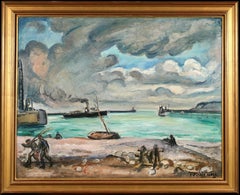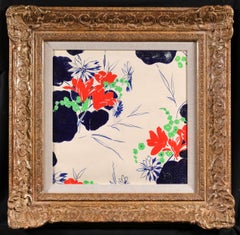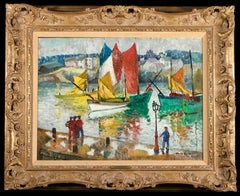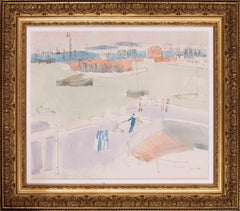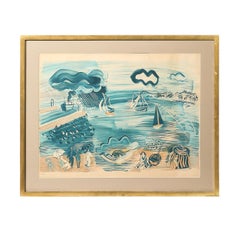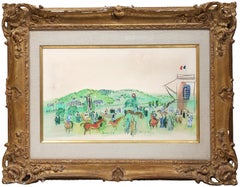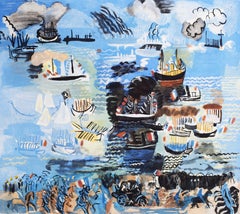Items Similar to Le Port due Havre - Post Impressionist Landscape Watercolor by Jean Dufy
Want more images or videos?
Request additional images or videos from the seller
1 of 12
Jean DufyLe Port due Havre - Post Impressionist Landscape Watercolor by Jean Dufy1924
1924
$15,067.10
£11,055
€12,962.64
CA$20,786.38
A$23,115.32
CHF 12,140.67
MX$282,607.96
NOK 151,284.33
SEK 142,620.26
DKK 96,743.16
About the Item
Signed and dated post impressionist watercolor on paper seascape by French painter Jean Dufy. This colourful piece depicts sail boats at the port of Le Havre in France - a commercial port overlooking the English Channel.
Signature:
Signed and dated 1924 lower right
Dimensions:
Framed: 24"x28"
Unframed: 17"x21"
Provenance:
Private French collection
This work is accompanied by a certificate from Mnr. Jacques Bailly and will be included in the updated to the catalogue raisonne under reference number 4945
Jean Dufy came from a family of nine children brought up in an artistic and, especially, musical environment. By the age of 14, Dufy was painting stage sets for family plays; his talents were recognised and nurtured by his older brother Raoul and the latter's friend Othon Friesz. He enrolled at the college of fine arts in Le Havre, where Raoul, Friesz and Georges Braque had also studied, but he abandoned his studies early on and moved to Paris to be with his brother who ultimately proved to be his mentor. He travelled extensively in Western Europe and North Africa. He served in a cavalry regiment during World War I, but by 1920 he was back in Paris, where he exhibited examples of his painting at the Salon d'Automne, of which he was already a member. He produced designs for the silk factories in Lyons and for the porcelain works in Limoges.
Dufy painted in oils, watercolours and occasionally Indian ink. Inevitably, his body of work is compared to that of his brother Raoul and, as far as choice of subject matter is concerned, they are often similar: views of Paris and other French cities, circus scenes, horse races, beach scenes, orchestras and the like. Jean Dufy's orchestra scenes have proved particularly useful in identifying his artistic signature compared with that of his brother Raoul, of whom it has frequently been said that he painted in a lively 'staccato' style, whereas Jean (himself a gifted classical guitarist and jazz musician) painted in a style that was smoother and more fluent, using deep blues interspersed with reds and greens, with points of yellow creating the effects of light. His purpose was to capture the overall impact of a scene rather than its uniqueness and individuality. He spent many years in the comparative seclusion of his farm near Nantes on the River Loire, where he painted canvases that exhibit a freshness and enthusiasm that he clearly shared with his more famous brother.
A Jean Dufy retrospective was held at the Reine Gallery in New York in 1966, two years after his death.
- Creator:Jean Dufy (1888 - 1964, French)
- Creation Year:1924
- Dimensions:Height: 24 in (60.96 cm)Width: 28 in (71.12 cm)
- Medium:
- Movement & Style:
- Period:
- Condition:Very good original condition - some small time stains.
- Gallery Location:Marlow, GB
- Reference Number:Seller: LFA02661stDibs: LU415315516482
Jean Dufy
Jean Dufy was a French Art Deco artist, best known for his colourful, melodic depictions of post-war Parisian society. Working to capture everyday life, from concert halls and circuses to country landscapes and busy Parisian streets, Dufy focused on recreating the feeling and impression of a scene, rather than individual details. In 1906, Dufy visited the exhibition ‘Cercle de l’Art Moderne’ in La Havre, and it was this show that eventually inspired him to pursue an artistic career. The exhibit, one of Dufy’s first exposures to Modern Art, crucially shaped his approach to art and introduced him to artists such as Picasso and Matisse. While he had no formal training, his older brother was well-known French Fauvist Raoul Dufy, who served as his artistic mentor. In January 1914, Dufy launched his artistic career, holding his first show at Galerie Berthe Weil. He returned to Paris after the war and settled in the Montmartre district of Paris, moving next door to artist George Braque, who encouraged Dufy to experiment with Cubism. His personal painting style developed into a vibrant fusion of Post-Impressionism with a loose decorative approach to colour and line, which he achieved from his work in porcelain design. For almost 30 years, Dufy worked for Limoge porcelain manufacturer Theodore Haviland, hand-painting decorative designs of animals and flowers. At the 1925 L’exposition Internationale des Arts Décoratifs he was awarded a gold medal for designing the service ‘Châteaux de France’. Dufy participated in many exhibitions, including the Salon d’Automne, which reflected the popularity of jazz music and the art of Parisian culture after the war. Dufy would return to his native Normandy throughout his life and spent long stretches of time in the south of France. The dynamism of these landscapes and cityscapes - particularly noticeable in the street scene Route de Rives (Touraine)- are so cleverly captured due to Dufy’s uniquely musical and distinctive Post-Impressionistic style.
About the Seller
5.0
Gold Seller
Premium sellers maintaining a 4.3+ rating and 24-hour response times
Established in 2001
1stDibs seller since 2016
708 sales on 1stDibs
Typical response time: <1 hour
- ShippingRetrieving quote...Shipping from: Marlow, United Kingdom
- Return Policy
Authenticity Guarantee
In the unlikely event there’s an issue with an item’s authenticity, contact us within 1 year for a full refund. DetailsMoney-Back Guarantee
If your item is not as described, is damaged in transit, or does not arrive, contact us within 7 days for a full refund. Details24-Hour Cancellation
You have a 24-hour grace period in which to reconsider your purchase, with no questions asked.Vetted Professional Sellers
Our world-class sellers must adhere to strict standards for service and quality, maintaining the integrity of our listings.Price-Match Guarantee
If you find that a seller listed the same item for a lower price elsewhere, we’ll match it.Trusted Global Delivery
Our best-in-class carrier network provides specialized shipping options worldwide, including custom delivery.More From This Seller
View AllBord de Riviere - Post Impressionist Figure in Landscape Watercolor by Jean Dufy
By Jean Dufy
Located in Marlow, Buckinghamshire
Signed and dated post impressionist figure in landscape watercolour on paper by French painter Jean Dufy. The work depicts a view of a grand house behind a wall with a large gated en...
Category
1920s Post-Impressionist Landscape Paintings
Materials
Paper, Watercolor
Port of Le Havre & Sainte-Adrese- Post Impressionist Seascape Oil - Othon Friesz
By Achille-Émile Othon Friesz
Located in Marlow, Buckinghamshire
Signed and dated oil on canvas seascape by French post impressionist painter Achille-Emile Othon Friesz. The piece depicts a view of Le Havre, a port city in Normandy, France, locate...
Category
1920s Post-Impressionist Landscape Paintings
Materials
Canvas, Oil
Projet de Tissus - Fauvist Flowers Watercolor & Gouache by Raoul Dufy
By Raoul Dufy
Located in Marlow, Buckinghamshire
Botanical watercolour and gouache on paper circa 1920 by French fauvist painter Raoul Dufy. The work depicts flowers in red, blue and green. This work was executed by Dufy as a fabric design.
Dimensions:
Framed: 19.5"x19.5"
Unframed: 12"x12"
Provenance:
Private collection of works by Raoul Dufy for Bianchini Ferier
Bianchini Ferrier Collection - Christie's London - July 2001
SF Fall Show
Raoul Dufy was one of a family of nine children, including five sisters and a younger brother, Jean Dufy, also destined to become a painter. Their father was an accountant in the employ of a major company in Le Havre. The Dufy family was musically gifted: his father was an organist, as was his brother Léon, and his youngest brother Gaston was an accomplished flautist who later worked as a music critic in Paris. Raoul Dufy's studies were interrupted at the age of 14, when he had to contribute to the family income. He took a job with an importer of Brazilian coffee, but still found time from 1892 to attend evening courses in drawing and composition at the local college of fine arts under Charles Marie Lhullier, former teacher of Othon Friesz and Georges Braque. He spent his free time in museums, admiring the paintings of Eugène Boudin in Le Havre and The Justice of Trajan in Rouen. A municipal scholarship enabled him to leave for Paris in 1900, where he lodged initially with Othon Friesz. He was accepted by the École des Beaux-Arts, where he studied under Léon Bonnat, whose innate conservatism prompted Dufy to remark later that it was 'good to be at the Beaux-Arts providing one knew one could leave'.
And leave he did, four years later, embarking with friends and fellow students on the rounds of the major Paris galleries - Ambroise Vollard, Durand-Ruel, Eugène Blot and Berheim-Jeune. For Dufy and his contemporaries, Impressionism represented a rejection of sterile academism in favour of the open-air canvases of Manet, the light and bright colours of the Impressionists, and, beyond them, the daringly innovative work of Gauguin and Van Gogh, Seurat, Cézanne, Toulouse-Lautrec and others. Dufy was an out-and-out individualist, however, and was not tempted to imitate any of these artists. He produced, between 1935 and 1937, Fée Electricité (Spirit of Electricity), the emblem for the French utilities company Electricité de France (EDF).
Dufy visited the USA for the first time in 1937, as a member of the Carnegie Prize jury. In 1940, the outbreak of war (and his increasingly rheumatic condition) persuaded him to settle in Nice. When he eventually returned to Paris 10 years later, his rheumatism had become so debilitating that he immediately left for Boston to follow a course of pioneering anti-cortisone treatment. He continued working, however, spending time first in Harvard and then in New York City before moving to the drier climate of Tucson, Arizona. The cortisone treatment was by and large unsuccessful, although he did recover the use of his fingers. He returned to Paris in 1951 and decided to settle in Forcalquier, where the climate was more clement. Within a short time, however, he was wheelchair-bound. He died in Forcalquier in March 1953 and was buried in Cimiez.
Between 1895 and 1898, Raoul Dufy painted watercolours of landscapes near his native Le Havre and around Honfleur and Falaise. By the turn of the century, however, he was already painting certain subjects that were to become hallmarks of his work - flag-decked Parisian cityscapes, Normandy beaches teeming with visitors, regattas and the like, including one of his better-known early works, Landing Stage at Ste-Adresse. By 1905-1906 Friesz, Braque, Matisse, Derain, Vlaminck, Van Dongen and Rouault were described collectively as Fauves (the wild beasts). What they had in common was a desire to innovate, but they felt constrained nonetheless to meet formally to set out the guiding principles of what promised to be a new 'movement'. Dufy quickly established that those principles were acceptable; moreover, he was most impressed by one particular painting by Henri Matisse ( Luxury, Calm and Voluptuousness) which, to Dufy, embodied both novelty and a sense of artistic freedom. Dufy promptly aligned himself with the Fauves. Together with Albert Marquet in particular, he spent his time travelling the Normandy coast and painting views similar...
Category
1920s Fauvist Still-life Drawings and Watercolors
Materials
Paper, Watercolor, Gouache
Harbour at St Ives - Impressionist Figures Seascape Oil by Richard Hayley Lever
By Richard Hayley Lever
Located in Marlow, Buckinghamshire
Signed figures in landscape oil on board by Australian-American impressionist painter Richard Hayley Lever. The work depicts brightly coloured sailing boats in the harbour of St Ives...
Category
Early 1900s Impressionist Figurative Paintings
Materials
Oil, Canvas
Projet de Tissus - Fauvist Still Life Study Gouache by Raoul Dufy
By Raoul Dufy
Located in Marlow, Buckinghamshire
Botanical gouache on paper circa 1920 by French fauvist painter Raoul Dufy. The work depicts a study of apples and pears. This work was executed by Dufy as a fabric design.
Dimensio...
Category
1920s Fauvist Still-life Drawings and Watercolors
Materials
Paper, Gouache
La Roses de Bagatelle - Fauvist Landscape Oil Painting by Louis Valtat
By Louis Valtat
Located in Marlow, Buckinghamshire
Signed fauvist oil on canvas landscape circa 1910 by French painter Louis Valtat. This stunning piece depicts a view of Bagatelle Park in the north of France in summer when all of th...
Category
1910s Fauvist Landscape Paintings
Materials
Canvas, Oil
You May Also Like
Jean Dufy, 1925 watercolour painting of the port of Le Havre, France
By Jean Dufy
Located in Petworth, West Sussex
Jean Dufy (French, 1888 – 1964)
Vue de port du Havre, circa 1925
Watercolour on paper
Signed ‘Jean Dufy’ (lower right) and inscribed on the reverse
19.1/4 x 23.1/4 in. (48.5 x 59 cm....
Category
20th Century Expressionist Landscape Drawings and Watercolors
Materials
Paper, Watercolor
Post Impressionist Lithograh entitled “LE HAVRE” by Raoul Dufy
By Raoul Dufy
Located in New York, NY
This losely rendered and highly narrative Post Impressionist Lithograh entitled “LE HAVRE” by Raoul Dufy originates from France, Circa 1930. A striking composition, this lithograph f...
Category
1930s Post-Impressionist Landscape Prints
Materials
Lithograph
Courses at Deauville, Original Modern Watercolor Painting by Raoul Dufy
By Raoul Dufy
Located in Long Island City, NY
Deauville is a French coastal town that has been a popular travel destination since the 1800s. The resort town is home to a grand casino, golf courses, and—as depicted here by Raoul Dufy—horse...
Category
1940s Impressionist Landscape Drawings and Watercolors
Materials
Paper, Watercolor, Gouache
Nautical Festival Fête nautique - France Nautical Dufy & Villon Collab
By Raoul Dufy
Located in London, GB
RAOUL DUFY 1877-1953
Le Havre 1877-1953 Forcalquier (French)
and
JACQUES VILLON 1875-1963
(Gaston Duchamp)
Damville 1875 - 1963 Paris (French)
Tit...
Category
1920s Landscape Prints
Materials
Aquatint
Le Vin Contre la Depression Nerveuse et l'Anemie
By Raoul Dufy
Located in Laguna Beach, CA
“My eyes were made to erase all that is ugly”. -Raoul Dufy
Raoul Dufy’s depictions for an instant charmer of a "medical book" illustrates the myriad benefits of wine, while being sp...
Category
1930s Post-Impressionist Landscape Prints
Materials
Lithograph
Dufy, Quai a Rouen, Raoul Dufy, Collection Pierre Lévy (after)
By Raoul Dufy
Located in Fairfield, CT
Medium: Lithograph on vélin d'Arches paper
Year: 1969
Paper Size: 20 x 26 inches
Inscription: Signed in the plate and unnumbered, as issued
Notes: From the folio, Raoul Dufy, IV, Col...
Category
1960s Modern Landscape Prints
Materials
Lithograph
$796 Sale Price
20% Off
More Ways To Browse
Raoul Dufy Watercolour
Children Playing On Beach
Raoul Dufy Framed
Horse Cavalry
Limoges Framed
Indian Boat
Limoges Yellow
French Cavalry
Porcelain D Art Limoges France
Lyon Silk
Raoul Dufy Boats
Antique Indian Silk Painting
Raoul Dufy Orchestra
Mexican Boat Paintings
Notre Dame Impressionist
Paul Bell
Railroad Oil Paintings
1960s Surreal Art
